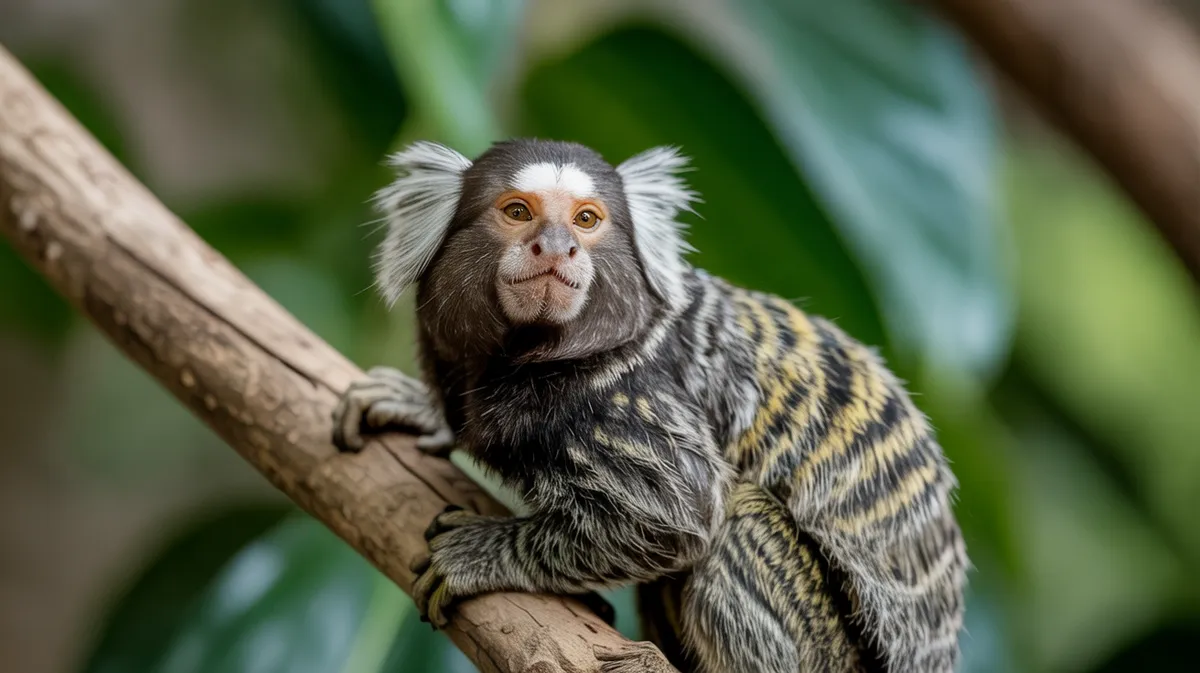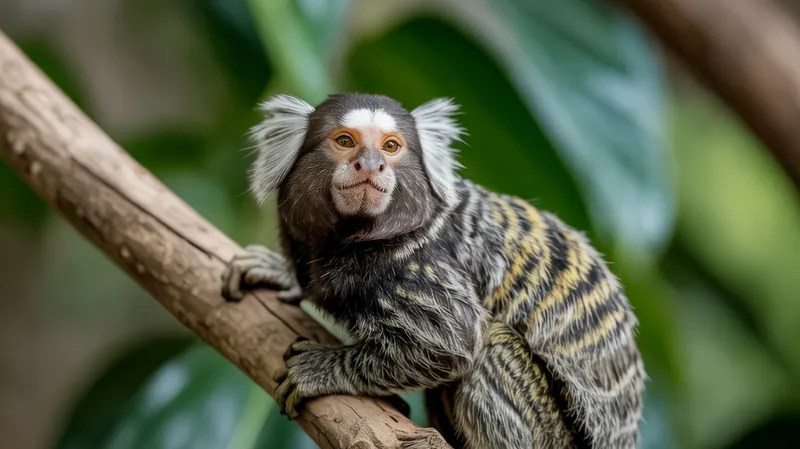
Common Marmoset
Callithrix jacchus

Meet the Common Marmoset
The common marmoset is a small New World monkey native to the northeastern forests of Brazil. Recognizable by its white ear tufts and expressive face, it is highly social and lives in family groups. Marmosets are agile tree-dwellers, using their sharp claws and long tails to navigate the forest canopy. They have a varied diet and communicate through vocalizations, scent marking, and body language. Despite habitat loss, the species is adaptable and often found near human settlements.
Classification
Mammal
Habitat
Tropical and subtropical forests
Diet
Omnivore
Lifespan
10-12 years in the wild
Conservation
Least Concern
Weight
250-350 grams
📖Fascinating Facts
Tree-Dwelling Experts
Common marmosets spend almost their entire lives in trees, rarely descending to the ground.
Family Structure
They live in close-knit family groups where both parents, siblings, and even unrelated group members help care for the young.
Special Teeth
Their lower incisors are enlarged and chisel-shaped, perfectly adapted for gouging tree bark to access sap and gum.
📋Detailed Description
The common marmoset (Callithrix jacchus) is a diminutive New World primate, typically weighing 250–350 grams and measuring 18–23 cm in body length, with a tail that can reach up to 29 cm. Its most distinctive features are the prominent white ear tufts, a banded tail, and a grizzled gray-brown pelage. The face is bare and expressive, aiding in complex social communication. Marmosets possess claw-like nails (tegulae) on most digits, an adaptation for vertical clinging and leaping in the forest canopy. Their dentition includes specialized lower incisors that are elongated and chisel-shaped, enabling efficient gouging of tree bark to access exudates such as gum and sap. Highly social, they live in cohesive family groups of 3–15 individuals, typically consisting of a breeding pair and their offspring. Vocal communication is sophisticated, including a range of calls for alarm, contact, and territorial defense. Scent marking is also integral to territory establishment and social hierarchy. Their activity is diurnal, with most foraging and social behaviors occurring in the early morning and late afternoon. The species is notable for its adaptability, thriving in both primary and secondary forests, edge habitats, and even urban environments.
💡 Did you know?
Unlike many primates, common marmosets rely heavily on tree sap and gum, which they extract by gnawing holes in bark with specialized lower incisors.
🔬Research & Sources
Wikipedia Summary
The common marmoset, also called white-tufted marmoset or white-tufted-ear marmoset, is a New World monkey. It originally lived on the northeastern coast of Brazil, in the states of Piauí, Paraíba, Ceará, Rio Grande do Norte, Pernambuco, Alagoas, and Bahia. Through release of captive individuals, it has expanded its range since the 1920s to Southeast Brazil, where it became an invasive species, raising concerns about genetic pollution of similar species, such as the buffy-tufted marmoset, and predation upon bird nestlings and eggs.
Last Modified: 5/11/2025
🎭Behavior & Social Structure
Common marmosets exhibit a complex suite of behaviors centered around group cohesion and resource acquisition. They are primarily arboreal and spend most of their time in the mid to upper canopy, rarely descending to the ground. Feeding behavior is highly specialized; they use their incisors to gouge holes in tree bark, feeding on exudates (gums, saps, resins), which can constitute up to 70% of their diet in some habitats. They supplement this with insects, small vertebrates, fruits, flowers, and nectar. Foraging is often a group activity, with individuals taking turns at feeding sites. Social interactions are frequent and include grooming, play, and vocal exchanges. Marmosets maintain territories of 0.5–6 hectares, which they defend through vocalizations and scent marking. Daily routines involve early morning and late afternoon foraging, midday rest, and communal sleeping in dense foliage or tree hollows.
👶Reproduction & Life Cycle
The common marmoset is characterized by a cooperative breeding system. Typically, only the dominant female in a group breeds, while subordinate females are reproductively suppressed through social and pheromonal cues. Mating is generally monogamous or polygynandrous. The gestation period lasts about 144–148 days, after which the female usually gives birth to non-identical twins, though singletons and triplets can occur. Neonates are altricial, weighing around 25 grams at birth. Parental care is highly communal: fathers and other group members (alloparents) assist with carrying, grooming, and feeding the infants, while the mother primarily nurses. Weaning occurs at 4–8 weeks, and juveniles become independent at 5–6 months. Breeding can occur year-round, but peaks are often observed during the rainy season when food is abundant.
🛡️Adaptations & Survival
Common marmosets display several notable adaptations. Their claw-like nails (except for the big toe) facilitate vertical climbing and clinging to tree trunks, unlike most primates with flat nails. Their specialized dentition allows efficient gouging of bark to access tree exudates, a niche food resource. Physiologically, they have a rapid reproductive cycle and high reproductive output, supporting population resilience. Socially, cooperative breeding and alloparenting enhance offspring survival. Their vocal repertoire is adapted for dense forest communication, with high-pitched calls that travel well through foliage. Behavioral flexibility enables them to exploit disturbed habitats and urban areas, feeding opportunistically on human-provided resources.
📚Research Sources
🎨Cultural Significance
In Brazilian culture, the common marmoset is often regarded as a symbol of agility and curiosity. It appears in local folklore and children's stories, sometimes as a mischievous or clever character. While not traditionally hunted for food, marmosets are sometimes kept as pets, a practice that is increasingly regulated due to conservation concerns. In scientific research, C. jacchus is a valuable model organism for studies in neuroscience, genetics, and infectious diseases, owing to its small size, rapid reproduction, and social complexity. The species also features in ecotourism and wildlife education programs in Brazil.
🔬Recent Research & Discoveries
Recent research has focused on the cognitive abilities of common marmosets, revealing advanced social learning, vocal turn-taking, and even rudimentary forms of empathy. Studies have mapped their genome, providing insights into primate evolution and genetic diseases. Invasive populations in southeastern Brazil are the subject of ongoing ecological and genetic monitoring, with concerns about hybridization and its impact on native species. Biomedical research has used marmosets to model neurodegenerative diseases, reproductive biology, and viral infections, including studies on Zika and COVID-19. Conservation research is increasingly addressing the effects of urbanization and habitat fragmentation on group dynamics and health.
🎥Wildlife Videos

A Common Marmoset Becomes a Substitute Parent 😎 Amazing Animal Friends | Smithsonian Channel
Two baby mongooses at the Daktari orphanage are getting a lot of attention from a common marmoset named Thor.
Smithsonian Channel

Marmosets The Tiny Foragers of the Rainforest 🌳🐒 A Wildlife Documentary
Explore the fascinating world of marmosets, the tiny primates of South America. Discover their unique sap-eating habits, agile ...
Genius1

Marmoset - 5 Minute Documentary
Join us on a captivating expedition into the enchanting world of the charming and agile marmoset in a mesmerizing five-minute ...
Five Minute Documentaries

S4 E2: "Secrets of the Common Marmoset"
In this episode of Wild Wonder, Blaze Wildlife takes you on an immersive exploration of the Common Marmoset. Uncover the ...
Blaze Wildlife

PRIMATE PLANET: Nature's Perfect Warriors | Full Documentary
Head into the wild and get to know some of our closest primate cousins, Monkeys. This documentary tours the globe, spending ...
Free High-Quality Documentaries

Common Marmoset
One of our newest exhibits here at the Billabong is our Common Marmosets. Common Marmosets are very small monkeys with ...
Billabong Zoo, Koala & Wildlife Park
🌍Habitat Information
The Common Marmoset typically inhabits Tropical and subtropical forests environments. Common Marmosets have adapted to their environments with specialized features and behaviors.
Primary Habitat:
Tropical and subtropical forests
More detailed habitat information will be available soon.
🛡️Conservation Status
The Common Marmoset is currently classified as Least Concern. Conservation efforts are crucial for preserving this species for future generations.
Common Threats:
- 🏠Habitat loss and fragmentation
- 🌡️Climate change impacts
- 🎯Hunting and poaching
- 🏭Human-wildlife conflict
⚠️Threats & Conservation Challenges
Although classified as Least Concern by the IUCN, common marmosets face several threats. Habitat loss and fragmentation due to agriculture, urbanization, and logging reduce available territory and food sources. Invasive populations in southeastern Brazil threaten native marmoset species through hybridization (genetic pollution) and competition, particularly with the buffy-tufted marmoset (Callithrix aurita). Predation by birds of prey, snakes, and small carnivores is a natural risk. In urban areas, vehicle collisions, electrocution, and disease transmission from humans are emerging concerns. The pet trade and biomedical research also contribute to population pressures in some regions. Despite these challenges, the species' adaptability has allowed it to maintain stable or expanding populations in many areas.
🔬Scientific Classification
Scientific Name
Callithrix jacchus
Classification Hierarchy
🔍 About Taxonomic Classification
Taxonomic classification is a hierarchical system used by scientists to classify and organize living organisms based on shared characteristics and evolutionary relationships.
The system moves from broad categories (Kingdom) to increasingly specific ones, with each animal's scientific name typically consisting of its Genus and species.
📝Community Notes
Share your observations and insights about the Common Marmoset with our community of wildlife enthusiasts.
Join Our Community
Sign in to share your observations and connect with fellow wildlife enthusiasts.
Sign In to ContributeNo community notes yet
Be the first to share your observations about the Common Marmoset!
Explore Common Marmoset
Select a tab above to learn more about this amazing animal.
📸Photo Gallery
No photos available for this animal yet.
🌟Discover More Wildlife
Continue your journey of discovery with more fascinating animals from our database
